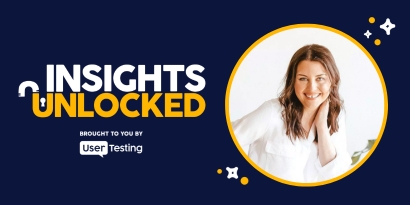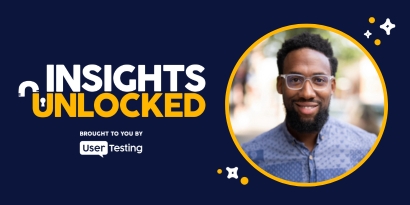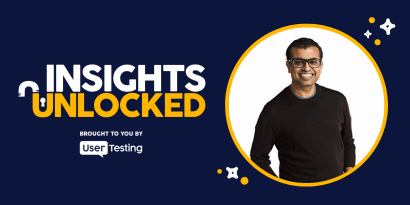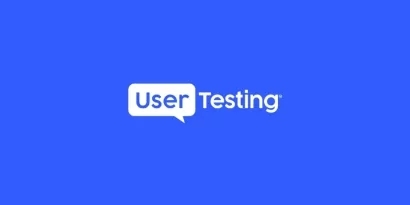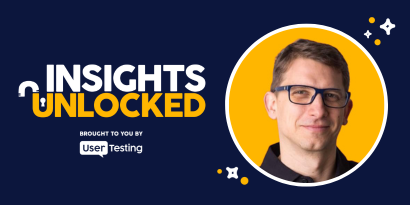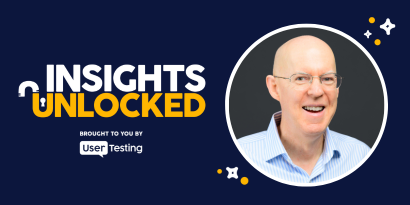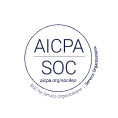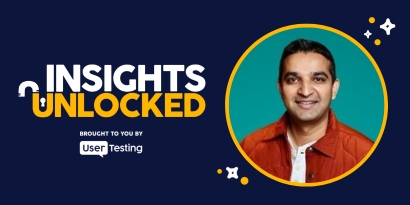
Episode 198 | November 24, 2025
Innovation-ish: Practical tools for everyday innovators
Tessa Forshaw and Rich Braden share practical ways to unlock innovation using empathy, design thinking, and smarter experimentation.
Rethinking innovation: how small behaviors unlock big creative breakthroughs
Most people don’t wake up in the morning thinking they’re innovators. They assume innovation belongs to “the geniuses,” the next Marie Curie, Grace Hopper or Mary Anderson of the world.
But that belief, deeply ingrained and often unexamined, has stopped countless promising ideas before they ever had a chance.
That’s one of the biggest takeaways from a recent Insights Unlocked conversation with Dr. Tessa Forshaw and Rich Braden, co-authors of Innovation-ish: How Anyone Can Create Breakthrough Solutions to Real Problems in the Real World.
Both teach design thinking and creative problem solving at institutions like Harvard and Stanford, and both have spent years studying how humans actually navigate innovation. Their conclusion? Innovation is much less about superhuman talent and much more about reshaping our mindsets, habits, instincts, and approaches to learning.
Below, we explore the surprising science behind innovation hesitation, the power of empathy, the spectrum of “shots” that make up innovative work, and the quiet skill that can help teams produce more ideas of higher quality: metacognition.
Understanding why innovation feels intimidating
One of the most relatable themes Tessa and Rich explore is why so many people instinctively recoil from innovative work even when they’re smart, curious, and capable. As Tessa explains during the interview, much of that hesitation is biological, rooted not in personality but in human evolution.
She describes how our ancestors’ survival depended on fitting in, not standing out. “There are really good reasons why you or Rich or I or anyone else might want to make sure that we stay as part of a group and don’t embarrass ourselves,” she says. “If you went off on your own, you became much less likely to survive.”
Innovation, however, often asks us to risk embarrassment: to share half-formed ideas, admit what we don’t know, question assumptions, or try something unproven. Our brains misinterpret these behaviors as danger. The amygdala—the almond-shaped part of the brain that monitors threat—activates. As Tessa puts it, “We often get into a situation that requires innovation and we assume that means risk and ambiguity… The amygdala starts ramping up its role.”
It’s a powerful reminder: the discomfort we feel around innovation isn’t a flaw. It’s a misapplied survival system.
The narrow image of who gets to be an innovator
Beyond biology, another major barrier is cultural. Tessa and Rich conducted a study asking people to name an innovator. “About 90% of them… actually named the same five people,” Tessa explains—Edison, Einstein, Gates, Musk, Zuckerberg.
When the public imagination is dominated by genius archetypes, it’s no wonder ordinary people feel excluded. Innovation becomes synonymous with brilliance, resources, and Silicon Valley mystique—not with everyday problem solving.
This myth, Rich argues, is one of the biggest obstacles to progress. “If innovation was only giant moonshot ideas,” he says, “I would be intimidated after all my experience teaching it.”
Which leads to one of his most helpful reframes.
Innovation happens across a spectrum—not just through moonshots
To dismantle the myth that innovation must be monumental, Rich introduces the “shots” framework: a portfolio-based way of thinking about creative work.
He describes it this way:
- Jump shots: Small feature improvements
- Roof shots: Bundles of enhancements that reshape a product
- Cloud shots: Innovations that expand impact beyond one product or experience
- Orbit shots: Big-category or industry-level redesigns
- Moonshots: Ambitious, paradigm-shifting ideas
“Whether you use exactly our names or not,” he says, “there’s a spectrum… underneath a moonshot, there are orbit shots, then cloud shots, then roof shots and jump shots.”
This hierarchy reframes innovation from a daunting leap to a series of achievable steps. Even the most daring moonshot depends on dozens of smaller innovations that make it possible: engineering advances, research insights, new tools, and operational improvements.
Rich offers a compelling real-world example: Neom, the futuristic city under construction in Saudi Arabia. The project includes a massive moonshot (“The Line,” a 100km-long vertical city). But behind that audacity are countless supporting innovations:
- Robots to bend previously unbendable rebar
- Specialized logistics systems to move unprecedented quantities of concrete
- New methods for lifting building segments safely in extreme wind
“Those aren’t revolutionary,” he notes, “but they’re critical.”
This insight helps teams realize that innovation belongs to everyone. The small improvements, the behind-the-scenes fixes, and the incremental ideas all contribute to something extraordinary.
ON-DEMAND WEBINAR
Discovery and innovation research
Empathy reshapes the brain—and drives better innovation
If innovation begins with understanding people, empathy is the engine that moves the process forward.
Tessa emphasizes the neurological benefits of empathy: “Your brain literally processes information differently when you engage in empathy,” she explains. Empathy “activates neural pathways that allow us to suspend assumptions and to deeply understand others’ experiences.”
Most teams, however, resist talking directly to customers or users. It feels uncomfortable, unpredictable, or time-consuming. But skipping empathy is like trying to solve a puzzle without looking at the pieces. Teams end up working from assumptions rather than realities, often generating solutions to problems no one has.
Empathy, on the other hand:
- reveals hidden tensions
- challenges our mental models
- makes us more cognitively flexible
- inspires insights we would never uncover through surveys alone
As Tessa notes, “Using empathy… you’re able to reshape and reconsider your understanding of certain circumstances.”
It is one of the simplest, yet most misunderstood, tools in creative problem solving.
Why insight requires evidence, not opinion
Rich also draws an important distinction between deep insights and everyday feedback. The difference, he explains, comes down to rigor and pattern recognition.
People naturally latch onto anecdotes, what he calls the “first story phenomenon.” But innovation requires more than one good interview. “You have to collect enough data so you can get past your biases,” he says. Then, you look for “surprises, contradictions, and tensions.”
When three or four people express similar frustrations, needs, or behaviors, those patterns form a foundation for innovation.
Evidence beats opinion, and trend beats anecdote.
Prototyping early and cheaply reduces innovation risk
Another essential theme in the conversation is the power of rapid prototyping, especially low-cost experiments that validate ideas before time and money are spent.
Instead of asking people whether they like an idea, Rich encourages teams to create real-world signals:
- Create a simple landing page with a “Buy now” button
- A mock product page
- An onboarding flow for a yet-to-be-built feature
- A simple video prototype
“If somebody clicks the buy button,” he notes, “we know they’re interested.” And if they go as far as entering shipping information? “Now that’s even better and stronger data.”
This approach shifts innovation from guessing to learning, reducing the risk of pursuing ideas that won’t resonate.
And with AI accelerating the prototyping process, these tests can be built in hours, not weeks.
Metacognition: the quiet skill that multiplies creativity
One of the most compelling concepts Tessa explores is metacognition in action—the practice of stepping back and examining how we’re thinking while we’re thinking.
It’s not the reflection that happens at the end of a project. It’s the tiny, real-time course corrections we make as we notice our habits and biases. For example:
- Changing how we take notes during interviews
- Pausing to question why one user’s comment felt more important than another’s
- Trying a new collaboration approach after noticing old patterns
- Sharing rough drafts earlier if revising in isolation hasn’t worked
In her research, students who used metacognitive strategies generated twice as many ideas, and their ideas were three times more novel.
Metacognition isn’t magic. It’s discipline. But it’s one of the most reliable ways to strengthen an innovation mindset.
GUIDE
Unlocking audience insights: driving smarter decisions across product, marketing, and UX
Storytelling helps teams adopt, support, and champion innovation
Innovation isn’t just about generating ideas, it’s about bringing people along. For that, Rich offers a tool from his background in improv: the Story Spine.
This simple structure:
- Once upon a time…
- Every day…
- But one day…
- Because of that… (repeat as needed)
- Until finally…
- And ever since then…
Completing the sentence starters helps innovators articulate their concepts clearly, concisely, and persuasively.
As Rich explains, “If you can’t tell a simple, straightforward story… you don’t really understand the idea yet.”
Storytelling turns ideas into narratives → and narratives into momentum.
Why innovation is hard work, but not hard
As the conversation comes to a close, Rich offers a final reflection on what innovation really demands: not genius, not perfection, not rare talent, but consistent effort.
“Innovation is not hard,” he says. “It’s hard work.”
A simple but powerful reminder that creativity isn’t reserved for a chosen few. It belongs to anyone willing to learn, engage, reflect, collaborate, test, and try again.
“Anything you’re learning needs to necessarily be effortful,” Tessa said. “And so you have to put in the work if you’re going to learn enough about a problem to solve it.”
Episode links
- Innovation-ish website
- Tessa Forshaw on LinkedIn
- Rich Braden on LinkedIn
- Jason Giles on LinkedIn
- Harvard's Next Level Lab
- Stanford's d.school
- Nathan Isaacs on LinkedIn
- Discovery and innovation research: On-demand webinar showing how customer insight fuels innovation.
- Continuous discovery: Transform your product development process: On-demand webinar about embedding insights throughout the design process.
- The executive’s guide to empathy-driven ROI: A guide for leaders on using empathy and human insight to drive innovation and growth.
- Design thinking and innovation with IDEO: Episode of Insights Unlocked exploring how design thinking drives innovation. UserTesting
- Empathy map: A guide for better digital experiences: Blog article on applying empathy and design-thinking methods to build better experiences.
- Kenn Adams' Story Spine narrative framework
